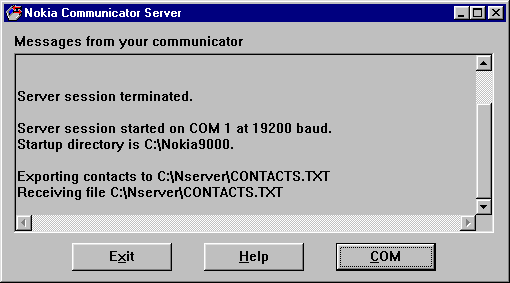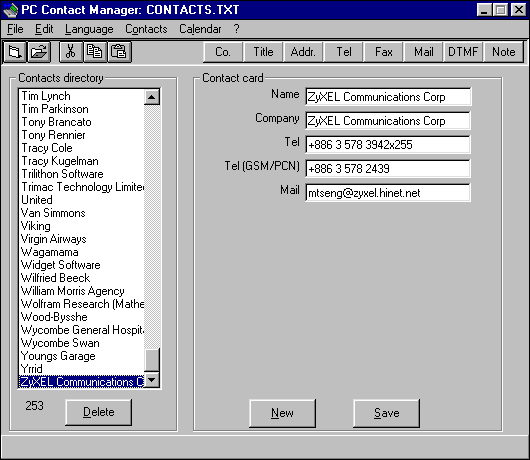
Nokia 9000
The Nokia 9000 mobile communicator

One of the more odd ball PDAs is the Nokia 9000 mobile phone. In appearance it is a normal Nokia GSM mobile, with an extra layer to the sandwich, so that it can open up rather like a spectacles case to reveal a keyboard and display underneath the mobole phone fascia. The PDA component uses the venerable GEOS operating system, which featured in the GeoWorks package that ran on normal desktop PCs. I have used one of these for about the last six months as my main mobile phone and occasional PDA.
The mobile phone personality of the Nokia 9000 is based on the excellent Nokia 2110; I have used the predecessors of this phone, and like them very much. The only significant difference of the Nokia 9000 is that it is very much thicker and heavier, to the extent that I don't put it into pockets to carry. It will fit into my rather large and stretchy jacket and trousers pockets, but distorts the shape so much that I prefer not to carry it this way.
The PDA aspect is, to be blunt, rather feeble. Applications include Contacts, Calendar, Notes, Calculator, and special features to manage faxes (both send and receive), SMS and to create your own custom ring sound. There is also a web browser and POP3/SMTP email application.
As an example of what I mean by feeble, consider the Internet application. If I have waited the 30 seconds or so required to set up an internet connection to look at a web page, and now want to check for email, I have to break the connection and start over. Similarly if I want to retain a connection between reading new emails and sending replies.
File Exchange Server for Nokia 9000

Some PC software comes with the Nokia 9000, but only a simple server program that can transfer files and do nothing else. Available from the Nokia web site is a PC Contacts Manager program, which can read and edit files downloaded via the Nserver program. It also provides synchronisation facilities, for the Calendar only, to Schedule+. If you want to update Contacts, you can only do it by deleting them using the software built in to the phone, which requires a special lock code, then replacing them with a files loaded and edited in the Contacts Manager. It you load a new file from your desktop PC without previously deleting the old details, you will end up with two entries for everyone in your file. You can create a file yourself, using a special format for the Nokia 9000, but it is hard work. As the Contacts Manager can read tab delimited files, it is much easier to go through the sequence using Contacts Manager. Both of these programs are resolutely Windows 3.1 in behaviour, although they will run on Windows 95. However, they won't cooperate with long file names. I don't enjoy having to struggle with them quite as much as I do.
Nokia Contacts Manager

The email and web facilities are excellent, and the package is reasonably compact if you would otherwise always carry a mobile phone and a PDA. Integration between the mobile phone facilities and the PDA components is similarly excellent. It is now quite feasible to sit in a field (at least in the Home Counties, where you have good GSM reception) and catch up with your email. A colleague who spends most of his day walking between customers in the City of London reckons that it fits his requirements almost precisely. However, if you are demanding of the facilities you require from a PDA, would sometimes like to carry just one or the other of the two devices, or demand a high level of interoperability with your desktop diary and contacts manager, almost anything else would be better.
Alternatives at the moment include using a GSM phone with a PCMCIA Data Card, and a PDA with PCMCIA support. That includes the Newton, most realistically, or Psion S3 with PsiMail Internet and the PCMCIA adaptor. The Psion S5 doesn't yet have either an email program or a GSM phone connection, but when these are available it will be a good option. Windows CE machines will work for limited periods in this combination, but the 2 AA batteries can only power PCMCIA cards for a limited time. CE machines should last longer with GSM cards (possibly around 20 minutes on a set of batteries) than with an analog modem card.
Some mobile phones are on the way that include a serial port, and present an interface through the serial port like that of a normal modem. These should have the advantage of being easy to connect to the Internet software of any PDA. The Eriksson GS18 should be the first of these to arrive.
Given that the best parts of the Nokia 9000 are the email and web applications, and the integration for the phone, the prospects for the next generation of mobile communicators (Nokia's label for the Nokia 9000) are excellent, and I look forward to trying one with a better PDA base: quite possibly the Psion EPOC/32 software.
Words and design by:
Paul Lynch
Last updated: September 8, 1997